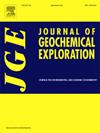Indoor radon and its relationship with rock uranium concentration in western Liguria (Italy)
IF 3.3
2区 地球科学
Q1 GEOCHEMISTRY & GEOPHYSICS
引用次数: 0
Abstract
We recorded indoor radon concentrations in dwellings and measured uranium, thorium and potassium contents in rocks of western Liguria (Italy). This area, characterised by a wide geo-lithological variability with rocks spanning from sedimentary to metasedimentary and metavolcanic, was never deeply investigated for indoor radon or uranium concentration. High levels of indoor radon concentration, exceeding 200 Bq m−3, were recorded in buildings located on the pre-Mesozoic basement that crops out for approximately 65 % of the survey area and shows a maximum average uranium concentration of about 7 mg kg−1. The uranium and the indoor radon concentrations measured on the same lithological groups are strictly correlated. Indoor radon concentrations >200 Bq m−3 are mostly recorded when the rock uranium content exceeds 4.5 mg kg−1. We suggest that the uranium‑radon correlation can be used as an effective baseline for studies of radon potential evaluation.
意大利利古里亚西部地区室内氡及其与岩石铀浓度的关系
我们记录了住宅室内氡浓度,并测量了利古里亚西部(意大利)岩石中的铀、钍和钾含量。该地区的特点是地质岩性变化很大,岩石从沉积岩到变质沉积岩和变质火山岩都有,但从未对室内氡或铀浓度进行过深入调查。在位于中生代前基底的建筑物中记录到的室内氡浓度高,超过200 Bq m - 3,约占调查区域的65%,显示出最高平均铀浓度约为7 mg kg - 1。在同一岩性群上测得的铀浓度与室内氡浓度具有严格的相关性。当岩石铀含量超过4.5 mg kg - 1时,室内氡浓度多为200 Bq m - 3。我们认为铀-氡相关性可以作为氡电位评价研究的有效基线。
本文章由计算机程序翻译,如有差异,请以英文原文为准。
求助全文
约1分钟内获得全文
求助全文
来源期刊

Journal of Geochemical Exploration
地学-地球化学与地球物理
CiteScore
7.40
自引率
7.70%
发文量
148
审稿时长
8.1 months
期刊介绍:
Journal of Geochemical Exploration is mostly dedicated to publication of original studies in exploration and environmental geochemistry and related topics.
Contributions considered of prevalent interest for the journal include researches based on the application of innovative methods to:
define the genesis and the evolution of mineral deposits including transfer of elements in large-scale mineralized areas.
analyze complex systems at the boundaries between bio-geochemistry, metal transport and mineral accumulation.
evaluate effects of historical mining activities on the surface environment.
trace pollutant sources and define their fate and transport models in the near-surface and surface environments involving solid, fluid and aerial matrices.
assess and quantify natural and technogenic radioactivity in the environment.
determine geochemical anomalies and set baseline reference values using compositional data analysis, multivariate statistics and geo-spatial analysis.
assess the impacts of anthropogenic contamination on ecosystems and human health at local and regional scale to prioritize and classify risks through deterministic and stochastic approaches.
Papers dedicated to the presentation of newly developed methods in analytical geochemistry to be applied in the field or in laboratory are also within the topics of interest for the journal.
 求助内容:
求助内容: 应助结果提醒方式:
应助结果提醒方式:


